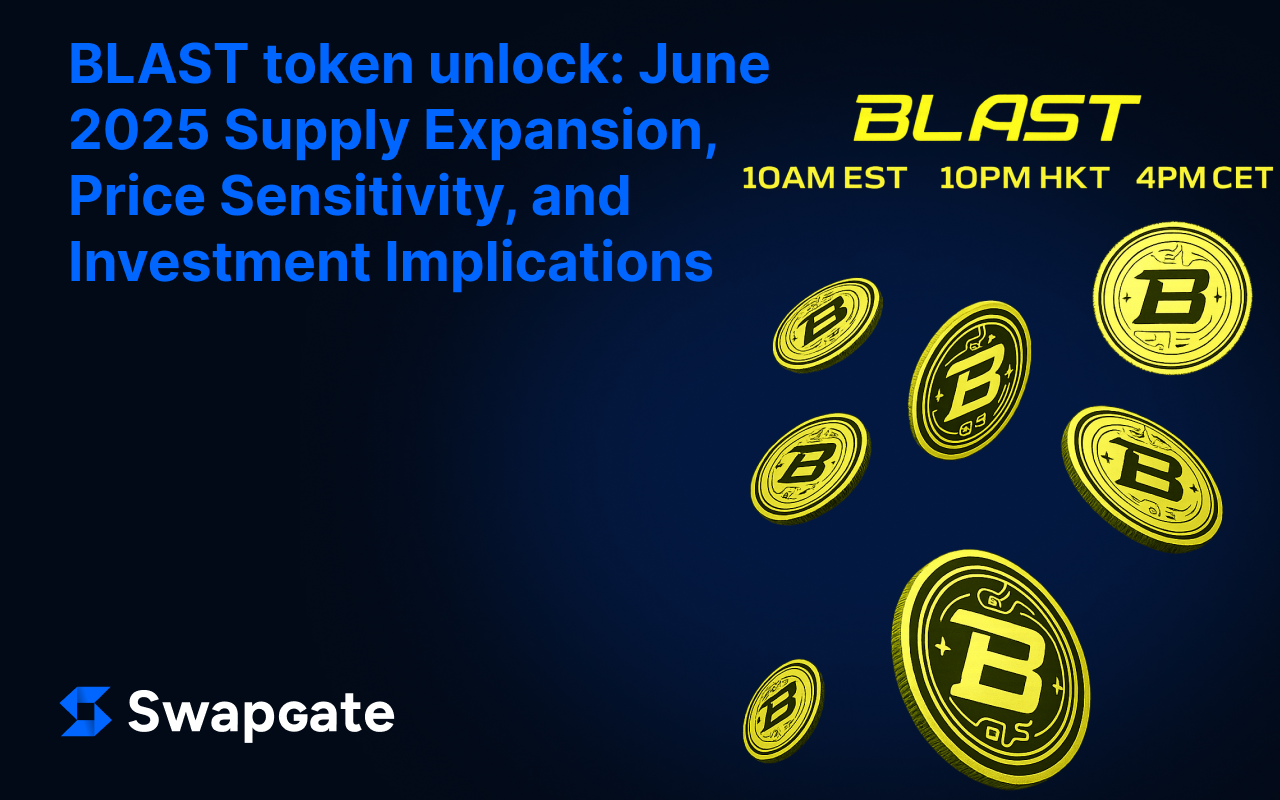
According to the official BLAST tokenomics document, 10.5B tokens unlock on June 26, 2025—roughly 54.9 % of the current circulating supply—into the secondary market. This BLAST unlock June 2025 event represents the single largest increase in tradable float since genesis, with a notional value close to US\$ 29 million at the prevailing spot price of US\$ 0.00245. Once the 10.5 billion BLAST tokens unlocked are incorporated into circulation, market depth, volatility, and relative value across Layer‑2 assets may be materially affected. This article is for experienced crypto investors and token holders considering exposure to BLAST around its June 2025 unlock.
Key Metrics:
- When is BLAST token unlock? 26 June 2025 02:00 PM UTC, per the project’s vesting schedule.
- How many BLAST tokens are unlocking? 10.5 billion, equal to 54.9 % of today’s circulating supply and 10 % of the max cap.
- Allocation buckets: community incentives, early‑stage investors, and core contributors.
- Locked‑to‑circulating transition: linear vesting after a one‑year cliff, with large discrete releases in certain intervals.
BLAST tokenomics
Blast utilises a 100 billion fixed‑supply model divided among community rewards (50 %), contributors (25.5 %), investors (16.5 %), and the Blast Foundation (8 %). Native yield of 4 % on bridged ETH and 5 % on bridged stablecoins is funded through on‑chain staking and protocol fees. So, these unlocks were engineered to progress linearly, yet several allocations—including the present release—arrive as sizeable cliffs that temporarily elevate supply‑side pressure.
Historical Precedent & Price Impact
Empirical analysis of comparable events exceeding 25 % of circulating supply (APT 2024, DYDX 2023, APE 2024) indicates a mean 12 % decline in the seven days preceding the event, followed by a capitulation wick on the execution date and a gradual re‑rating once uncertainty dissipates. So, magnitude and duration of drawdown have been most closely correlated with dollar value relative to average daily trading volume and with prevailing systemic liquidity.
Scenario Analysis: what will happen to BLAST price
Baseline modelling assumes 40 % of the unlocked tranche becomes immediately liquid. With average daily volume below US\$ 8 million, the effective float could expand by more than four days’ worth of turnover, supporting a temporary price concession. Under median conditions, spot quotations are projected to range between US\$ 0.00170 and US\$ 0.00240 during the first post‑unlock week, consistent with prior supply‑shock dynamics in similarly capitalised tokens.
Forward Estimates: BLAST price forecast after unlock
Forecasting engines from CoinCodex and Gov.Capital converge on a six‑month fair‑value band of US\$ 0.00180‑0.00220, implying a roughly 15 % discount to pre‑unlock levels. Tail outcomes skew negative if systemwide risk sentiment deteriorates, but positive convexity is observed when new dApps migrate liquidity to Blast or when macro conditions improve.
On‑Chain Positioning: whale insights on BLAST
Arkham Intelligence identifies differential behaviour among the fifty largest holders. A subset of early‑stage funds has routed vested allocations toward centralised exchanges since early May 2025, whereas several airdrop recipients have opted to stake newly‑released tokens in Blast Earn contracts. So, this divergence suggests heterogeneous time horizons and limits the predictive value of singular address activity.
Supply‑Side Dynamics: BLAST sell pressure expected
Assuming the indicated 40 % conversion to immediate liquidity, an estimated US\$ 10‑12 million in potential sell flow could exceed two standard deviations of average daily taker volume, increasing the probability of order‑book slippage and wider bid–ask spreads during the unlock window.
Valuation Framework: should you sell BLAST
Portfolio decisions depend on mandate, horizon, and risk tolerance. Short‑term tactical frameworks often seek to reduce exposure ahead of large unlocks and re‑enter during price stabilisation. Long‑horizon strategies tend to emphasise protocol fundamentals and may hold or incrementally accumulate if long‑term revenue projections remain intact.
Macro Context
The United States Federal Reserve maintained policy rates at 4.25‑4.50 % on 18 June 2025, and Chair Powell reiterated a “higher for longer” stance. Equity–crypto correlations, which reverted above 0.5 in early 2025, indicate elevated sensitivity to equity drawdowns. Concurrently, European markets face uncertainty linked to France’s legislative snap election, constraining global risk appetite. Historical evidence demonstrates that unlock‑induced weakness persists longer under restrictive liquidity regimes.
Real‑Time Monitoring: market reaction to BLAST unlock
High‑frequency tracking of exchange inflows, funding‑rate shifts, and intraday volatility in the three‑hour interval surrounding the unlock timestamp can provide actionable information regarding absorption efficiency and residual overhang.
Investor Segmentation: how unlock affects investors
Passive holders experience proportional dilution of voting power and prospective fee claims. Active traders confront elevated volatility that can be harnessed through mean‑reversion or momentum strategies, provided risk controls are well‑defined.
Event Characterisation: BLAST major token unlock
The June 2025 distribution marks the project’s largest vesting event to date, eclipsing prior cliffs both in nominal token count and percentage of circulating supply, thereby establishing a critical test of market capacity to absorb supply shocks.
Conclusion
In conclusion, the June 2025 supply expansion constitutes a significant inflection point in BLAST’s issuance profile. Historical analogues, order‑book depth, and on‑chain positioning collectively indicate an elevated probability of short‑term price compression; however, the long‑term valuation trajectory remains contingent on continued network adoption and yield sustainability. From an investment standpoint, BLAST exhibits high beta and pronounced event‑driven volatility. Accordingly, the asset may be appropriate for risk‑tolerant participants capable of withstanding liquidity shocks and monitoring protocol‑specific execution metrics, whereas low‑volatility or income‑oriented portfolios may find the risk–return profile less suitable. Don’t forget, you can always swap BLAST on Swapgate after its official unlock.
This analysis is for informational purposes only and does not constitute investment advice. Readers should conduct their own research and consult professional advisors (DYOR).